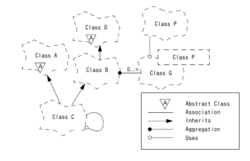
Back Grady Booch#Booch-Notation German Metodología de Booch Spanish روش بوچ Persian Méthode Booch French Booch-módszer Hungarian Metodo Booch Italian Booch法 Japanese Metoda Boocha Polish
It has been suggested that this article be merged into Grady Booch#Booch method. (Discuss) Proposed since June 2024. |
Parts of this article (those related to article) need to be updated. (July 2023) |

The Booch method[1] is a method for object-oriented software development. It is composed of an object modeling language,[2] an iterative object-oriented development process,[3] and a set of recommended practices.[4]
The method was authored by Grady Booch when he was working for Rational Software (acquired by IBM), published in 1992 and revised in 1994. It was widely used in software engineering for object-oriented analysis and design and benefited from ample documentation and support tools.[5]
The notation aspect of the Booch methodology was superseded by the Unified Modeling Language (UML), which features graphical elements from the Booch method along with elements from the object-modeling technique (OMT) and object-oriented software engineering (OOSE). Methodological aspects of the Booch method have been incorporated into several methodologies and processes, the primary such methodology being the Rational Unified Process (RUP).[citation needed]
- ^ Booch, Grady (1993). Object-oriented Analysis and Design with Applications (2nd ed.). Redwood City: Benjamin Cummings. ISBN 0-8053-5340-2.
- ^ Booch, Grady (1994). "Chapter 5:Notation". Object-Oriented Analysis and Design with Applications (2nd ed.). Addison-Wesley. ISBN 0-8053-5340-2.
- ^ Booch, Grady (1994). "Chapter 6:The process". Object-Oriented Analysis and Design with Applications (2nd ed.). Addison-Wesley. ISBN 0-8053-5340-2.
- ^ Booch, Grady (1994). "Chapter 7:Pragmatics". Object-Oriented Analysis and Design with Applications (2nd ed.). Addison-Wesley. ISBN 0-8053-5340-2.
- ^ Martin, Robert Cecil (1995). Designing Object-Oriented C++ Applications using the Booch Method. Prentice-Hall. ISBN 0-13-203837-4.
© MMXXIII Rich X Search. We shall prevail. All rights reserved. Rich X Search